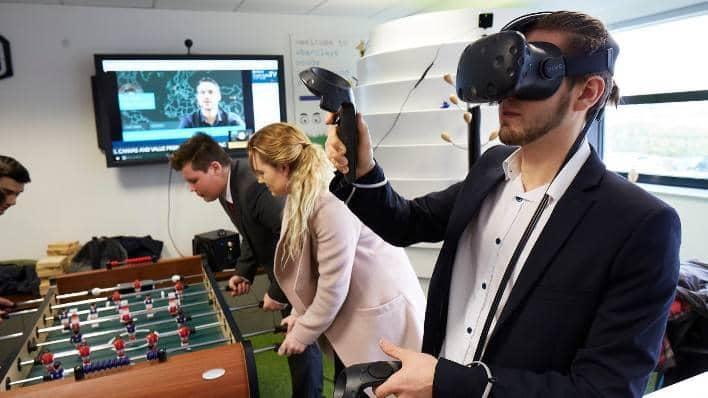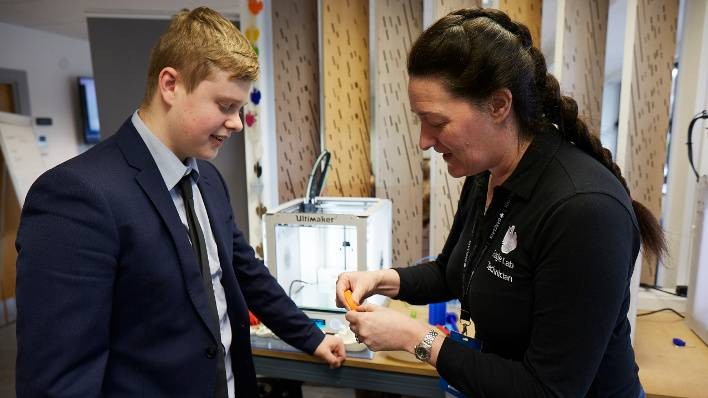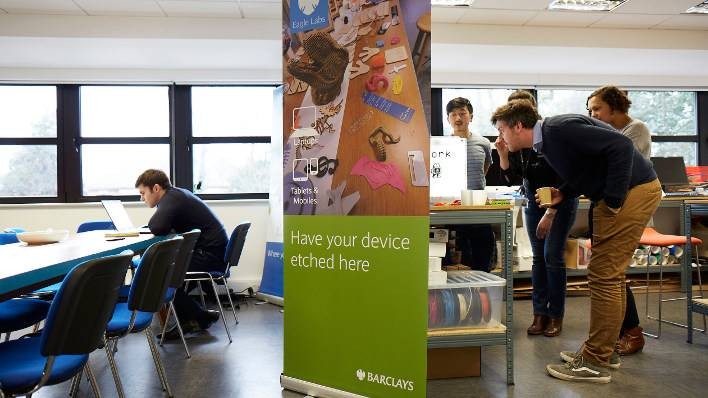
A day in the life of the Bournemouth Eagle Lab
Bournemouth is one of nine Barclays Eagle Labs across the country, from Jersey to Salford. Just over a year after its launch, we spent a day there finding out what goes on in the buzzing environment of a Lab … and how to make an animatronic dragon.
It’s 10am and Harry Baker, Eagle Lab Manager, and Sharon Jones, Lab Technician, are bracing themselves for the arrival of a group of teenagers from Bournemouth and Poole College. Tables in the communal workspace area are pushed together and pens and notebooks readied. Sharon makes sure the VR headset – not officially part of the training but very likely to be picked up by the students in their breaks – is in working order.

Lab technician Sharon Jones talks through potential wristband materials with young entrepreneur Ashley, 18, from Bournemouth and Poole College
“It’s about what we can give”
The students take their seats. There are 14 of them aged between 16 and 18 – six girls and eight boys, dressed smartly in suits – all studying towards a BTEC diploma in business. Diane Trott, a business relationship manager, talks them through an A-Z of starting a business.
They discuss intellectual property, finance, using social media and web advertising. Then it’s on to branding and logo design with Sharon, who shows the students a range of innovative business cards. They look at the Barclays Eagle logo and how it has changed over time to become a simplified silhouette.
“Something that makes people look more than once is really important,” says Sharon. “You want to create something that will be instantly recognisable as yours. Sadly, the Apple icon is taken!”
This is the students’ second visit to the lab. They first visited at the start of their course in September and will come again to pitch their business plans to a Dragons’ Den-style panel later in the year.
“The staff here have been amazingly helpful,” says Katherine Howes, the college’s enterprise apprenticeship coordinator. “They’ve created a bespoke experience for the students, giving them one-to-ones and bringing in other specialists. It’s good for them to be in an environment with other businesses. Education shouldn’t all be down to schools and colleges.”
In the workspace, Sharon is talking Ashley, 18, through possible materials for the wristbands he wants to produce to promote his idea for a festival app. They consider tan leather but settle on a fluorescent orange silicone. Back at the desks, Amie, 16, Rhia, 18, and Liv, 16, are discussing their plans for a joint fashion marketing business. “There are so many boutiques in the town that aren’t promoting themselves online,” says Amie. “We want to be able to help with websites, with shoots, get them on Instagram.”
It’s 12 noon and the end of the session. “Remember you’re very welcome to come back next week to make use of the equipment,” Sharon tells them. “Come and talk to me or call up to book in a free appointment.” Ashley will definitely be back. “When all of this is in front of you, it’s pretty hard to believe,” he says. “It’s amazing really to have this kind of access. They’ve been able to help me with my logo and finding funding. If it all goes to plan I would hope to be at festivals all over the world in the next two or three years.”
Diane and her colleague Emma Farrell, a premier relationship manager who is also visiting to help out with the students, take a well-earned break in the chairs near the Lab’s private ‘beach-hut’ rooms. Both have worked for Barclays for more than 30 years. “I love working with the Lab because it’s so community focused. It’s not about what we can gain from them: it’s about what we can give,” says Diane.

Entrepreneur Pete Beckett makes use of the maker space while one of the Lab’s regular clients works in the communal area
“Everyone here is really motivated to help”
It’s nearly lunchtime. James Seddon, digital designer at 3 Sided Cube, comes in to discuss a new project. His design agency is on another floor in County Gates House, where the Lab is based, and he has been working with Sharon on producing a welcome gift for one of their clients, the RSPB.
“Because the RSPB is involved in a number of protected spaces along our coastline, we had the idea of making something from natural materials,” he says. The plan is to use the laser cutter to make drinks coasters from driftwood collected by Sharon over the weekend.
Twenty minutes later James is holding a beautifully etched coaster, with a bird design on one side and the RSPB logo on the other. Sharon explains that the agency has a deal to use the Lab equipment for 12 hours a month.
“Now they’re able to offer something they couldn’t before,” she says. “It’s about helping them expand and extend what they do.”
It’s 1pm and Sharon and Harry grab a quick lunch. Sharon’s sandwich remains half eaten next to the 3D printers – dubbed ‘Mork’ and ‘Mindy’ (after the cult US sitcom starring Robin Williams) – when her next appointment, Pete Beckett, walks through the door. Pete is an electrical engineer working on sonar systems with an idea for a new doorbell app, and has come in to discuss a prototype for the doorbell attachment. “It’s amazing to have this kind of access because 3D printers aren’t cheap,” says Pete, who discovered the Lab after moving to Bournemouth over the summer.
It’s now 3pm and Chris Mew, founder of Locum Organiser, is taking a break near the coffee machine. He is one of the 22 people from 14 companies who work in the Lab regularly – in his case renting ‘The Other Room’, one of the two small office spaces. “I was looking to recruit a developer and needed somewhere social and pleasant,” he says. “This is a great environment.”
He says he has benefited hugely from the Lab’s “challenging” business mentoring programme, in which he meets regularly with an established entrepreneur. “He has grown and scaled a software company from scratch, which is exactly what I want to do,” says Chris.
Lab manager Harry, who set up the scheme, says every company joining the space is interviewed to find out how they can be supported. “We find out their turnover, their strengths, their stress points, how they see their future,” he explains. “Then we create a programme of activity with local entrepreneurs or professionals who want to give back.”

Sadie, 11, and Soraya, 10, make adjustments to the animatronic dragon they are creating in the after-school MakerClub
“Can I put Kylo Ren in it?”
It’s 5.30pm and weary-looking parents are dropping their children off for the MakerClub, a weekly after school technology club for eight to 14-year-olds.
“We wanted an after-school activity that was based on learning – something a bit geeky,” says Dionne Bell, mother of 10-year-old Barney, who comes to MakerClub with his best friend Max. “It’s Barney’s favourite part of the week.”
Three girls and five boys take their seats around black laptops. The announcement from the club teacher Ellie Keen that they’re going to start by learning how to code a basic Star Wars game is met with cries of “I love Star Wars”.
It’s not long before the theme tune from a galaxy far, far away is ringing out through the Lab’s main television. “How on earth did you do that?” Ellie asks the boy concerned. “I don’t know!” he says, laughing. Sam, 9, is using JavaScript code to make a BB-8 droid move across the screen. “Can I put Kylo Ren in it?” he asks.
That activity over, the kids turn their attention to their animatronic dragon projects. They have been split into pairs to make one from scratch, and this week they’re finishing designing and painting the cardboard box base before they build and programme a simple circuit board to make the wooden dragons move.
“It’s so cool,” says Barney, who is securing together wooden pieces made using the laser cutter to create his dragon. “I enjoy designing it and putting the whole thing together from scratch. I can’t believe you can make a dragon that moves by itself with just a motor and some wood.”
Sadie, 11, is painting the base for the animatronic dragon she’s building with Soraya, 10. “We’re doing a dragon that comes out of a volcano,” she says, making “lava” from blobs of paint. “I like that you get to do things that you don’t normally do at other clubs.” Ellie says the beauty of the club – which also introduces 3D printing, computer-aided design and the Internet of Things – is that it teaches children that computers “aren’t just for playing with. They can find out how to actually make things happen on screen.”
It’s close to 7pm. Packing up the maker space for the night, Sharon reminds Ellie to use the back exit when they leave. “I love the variety of working here,” says the former primary school teacher. “You can’t predict what your day is going to bring. Every day you have something incredible happen. It’s that sense of helping people to fulfil their ambition and dream.
“We have had visitors from babes in arms through to someone in their 90s. It’s a cross section, from people who have invested thousands in the community to people who are looking to start something from scratch. We never know who will walk through the door. The biggest feedback we get is: “I came in with one idea and I walked out with five more”.
“I feel enormously privileged to be doing what I’m doing,” she adds. “It’s not a nine-to-five job but what you get to do is incredible. I’ve never learned so much so fast.”